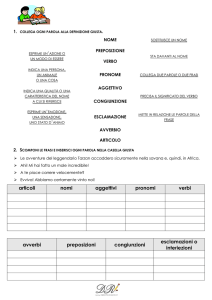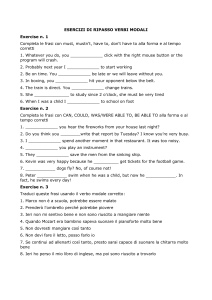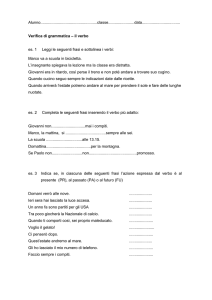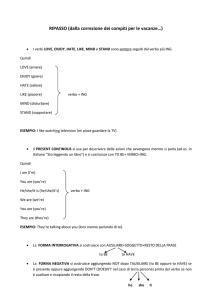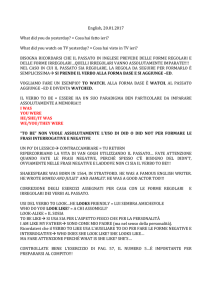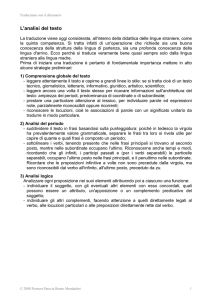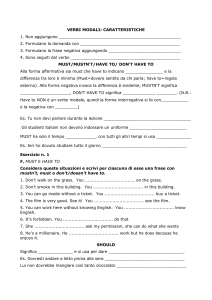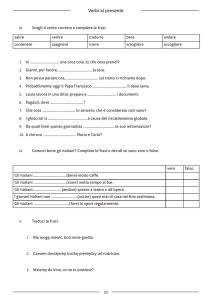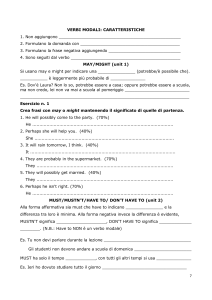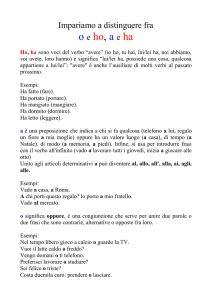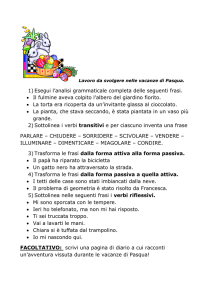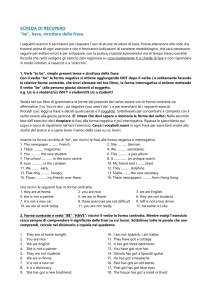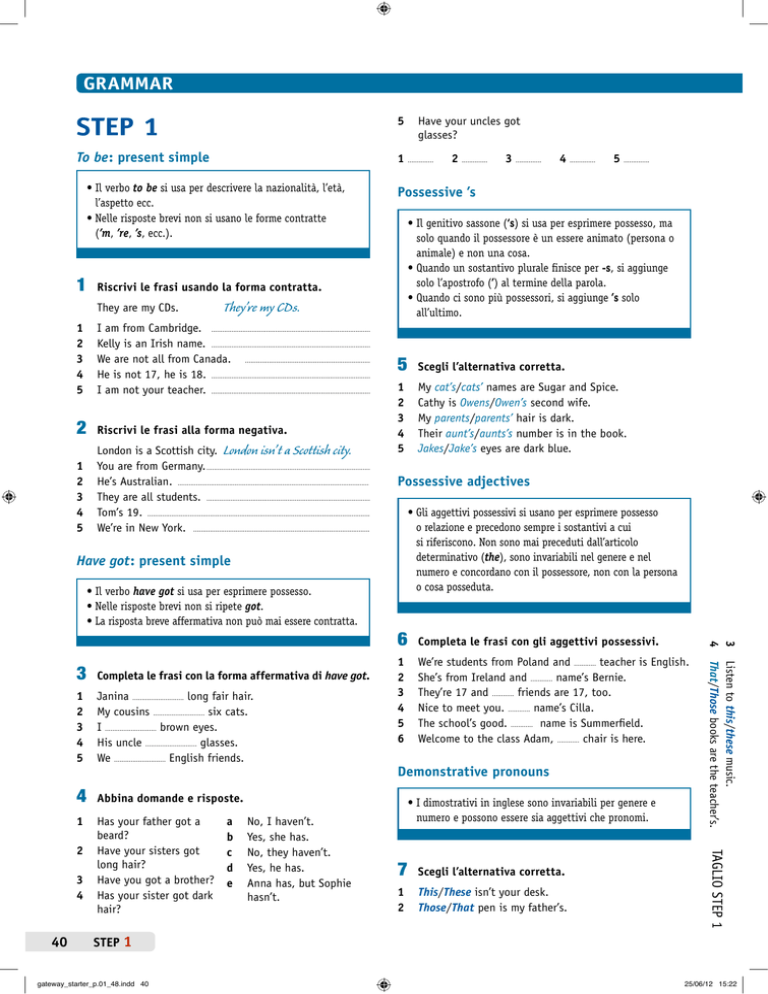
GRAMMAR
step 1
5 Have your uncles got
glasses?
To be: present simple
1 .............. 2 .............. 3 .............. 4 .............. 5 ..............
• Il verbo to be si usa per descrivere la nazionalità, l’età,
l’aspetto ecc.
• Nelle risposte brevi non si usano le forme contratte
(’m, ’re, ’s, ecc.).
1
Riscrivi le frasi usando la forma contratta.
They are my CDs.
1
2
3
4
5
I am from Cambridge. .......................................................................................
Kelly is an Irish name. .......................................................................................
We are not all from Canada. ....................................................................
He is not 17, he is 18. .......................................................................................
I am not your teacher. .......................................................................................
2
Riscrivi le frasi alla forma negativa.
1
2
3
4
5
London is a Scottish city. London isn’t a Scottish city.
You are from Germany..........................................................................................
He’s Australian. ........................................................................................................
They are all students. .........................................................................................
Tom’s 19. .........................................................................................................................
We’re in New York. ................................................................................................
They’re my CDs.
Have got: present simple
• Il verbo have got si usa per esprimere possesso.
• Nelle risposte brevi non si ripete got.
• La risposta breve affermativa non può mai essere contratta.
Completa le frasi con la forma affermativa di have got.
1
2
3
4
5
Janina ............................ long fair hair.
My cousins ............................ six cats.
I ............................ brown eyes.
His uncle ............................ glasses.
We ............................ English friends.
4
Abbina domande e risposte.
40
a
b
c
d
e
No, I haven’t.
Yes, she has.
No, they haven’t.
Yes, he has.
Anna has, but Sophie
hasn’t.
5
Scegli l’alternativa corretta.
1
2
3
4
5
My cat’s/cats’ names are Sugar and Spice.
Cathy is Owens/Owen’s second wife.
My parents/parents’ hair is dark.
Their aunt’s/aunts’s number is in the book.
Jakes/Jake’s eyes are dark blue.
Possessive adjectives
• Gli aggettivi possessivi si usano per esprimere possesso
o relazione e precedono sempre i sostantivi a cui
si riferiscono. Non sono mai preceduti dall’articolo
determinativo (the), sono invariabili nel genere e nel
numero e concordano con il possessore, non con la persona
o cosa posseduta.
6
Completa le frasi con gli aggettivi possessivi.
1
2
3
4
5
6
We’re students from Poland and ............ teacher is English.
She’s from Ireland and ............ name’s Bernie.
They’re 17 and ............ friends are 17, too.
Nice to meet you. ............ name’s Cilla.
The school’s good. ............ name is Summerfield.
Welcome to the class Adam, ............ chair is here.
Demonstrative pronouns
• I dimostrativi in inglese sono invariabili per genere e
numero e possono essere sia aggettivi che pronomi.
7
Scegli l’alternativa corretta.
1 This/These isn’t your desk.
2 Those/That pen is my father’s.
TAGLIO STEP 1
1 Has your father got a
beard?
2 Have your sisters got
long hair?
3 Have you got a brother?
4 Has your sister got dark
hair?
• Il genitivo sassone (‘s) si usa per esprimere possesso, ma
solo quando il possessore è un essere animato (persona o
animale) e non una cosa.
• Quando un sostantivo plurale finisce per -s, si aggiunge
solo l’apostrofo (’) al termine della parola.
• Quando ci sono più possessori, si aggiunge ’s solo
all’ultimo.
3 Listen to this/these music.
4 That/Those books are the teacher’s.
3
Possessive ’s
STEP 1
gateway_starter_p.01_48.indd 40
25/06/12 15:22
GRAMMAR
step 2
Plurals
There is/There are
• There is (c’è) si usa con i sostantivi singolari.
• There are (ci sono) si usa con i sostantivi plurali.
• There are (forma affermativa) non è mai contratto.
1
Scegli l’alternativa corretta.
1 There is/There are twenty windows in this house.
2 Is there/Are there a TV in your kitchen? Yes, there is/
there are.
3 Is there/Are there one window in the room?
4 There’s/There are twenty tables in the cafeteria.
5 There isn’t/There aren’t a swimming pool in our town.
6 Is there/Are there three girls in your football team?
No, there isn’t/there aren’t.
2
Abbina le frasi.
1 There are three
computers here.
2 There are four boys in
the garden.
3 There’s an armchair in
the room.
4 There is a good
restaurant in town.
5 There isn’t a clock in
my bedroom.
6 There’s a genius in
our class.
3
1
2
3
4
5
6
a It’s good, but it’s
expensive.
b Maths is easy for her.
c I don’t know the time.
d Is there a sofa too?
e They all have Windows
XP.
f They are my cousins.
Completa le frasi con la forma corretta di there
is(n’t) o there are(n’t).
a fast-food restaurant in our town.
.............................................. a sports centre here, but the
swimming pool’s great.
.............................................. three cinemas in the centre.
We prefer parks where .............................................. big, unfriendly
dogs.
.............................................. twelve boys and ten girls in our class.
The apartment hasn’t got a kitchen, but
.............................................. a microwave in the living room.
• Il plurale dei sostantivi si forma aggiungendo una -s.
• Ci sono però alcune irregolarità. I sostantivi che terminano per:
– -s, -x, -z, -sh, -ch, -o aggiungono -es
– -o di origine straniera aggiungono -s (radio/radios,
photo/photos)
– -y preceduta da una consonante trasformano la -y in -i
e aggiungono -es
– -f/-fe si trasformano in –ves (leaf/leaves).
4
Scrivi il plurale dei seguenti sostantivi.
1 school
2 half
3 woman
4 fish 5 class
6 friend
7 domino
8 person
9 garden
10 shelf
11 sofa
12 chair
13 man
14 mouse
15 photo
................................................................................................................
................................................................................................................
................................................................................................................
................................................................................................................
................................................................................................................
................................................................................................................
................................................................................................................
................................................................................................................
................................................................................................................
................................................................................................................
................................................................................................................
................................................................................................................
................................................................................................................
................................................................................................................
................................................................................................................
Prepositions of place
• Le preposizioni di stato in luogo seguono sempre un verbo
di stato (to be, to live ecc.).
Non possono mai essere utilizzate con verbi di moto (to
go, to fly ecc.).
..............................................
5
Correggi le frasi in cui la preposizione è sbagliata.
1 The teacups are in the shelf above the sink.
..........................................................................
2 The teacher usually stands behind the class.
..........................................................................
3 My dog sleeps above her bed.
..........................................................................
4 There’s a light on the wall above my bed.
..........................................................................
5 The bus stops under the cinema.
..........................................................................
6 Dad sits near the TV when he hasn’t got his glasses.
..........................................................................
STEP 2
gateway_starter_p.01_48.indd 41
41
25/06/12 15:22
GRAMMAR
step 3
4
Does she like rap music?
Present simple: affirmative and negative form
• Il present simple si usa per:
– affermazioni di carattere generale e dati di fatto;
– parlare di azioni abituali;
– esprimere preferenze e avversioni.
1
1
2
3
4
5
6
7
8
9
Completa le frasi con il present simple dei verbi tra
parentesi.
We ................................... (start) school at quarter to nine.
She ................................... (take) her chair to the kitchen.
He ................................... (answer) all the questions.
They ................................... (finish) their homework before
dinner.
I ................................... (clean) the board for the teacher.
Mrs Brown ................................... (ask) difficult questions.
You ................................... (have) a break after lesson two.
My cat ................................... (sit) on my homework.
We all ................................... (stand) up for the head teacher!
2
Riscrivi le frasi alla forma negativa.
1
2
She likes coffee for breakfast.
She doesn’t like coffee for breakfast.
I do my homework at school. ......................................................................
They go to bed in the afternoon.
......................................................................
3 He watches television before school.
Scrivi le domande per queste risposte.
No, she doesn’t. She likes rock music.
1
2
3
4
5
1
............................................................................................................................
?
No, he doesn’t. He has lunch at home.
?
No, she doesn’t. She plays hockey on Wednesdays.
............................................................................................................................ ?
No, they don’t. They study French.
............................................................................................................................ ?
No, she doesn’t. She lives in London.
............................................................................................................................
Completa le domande e scrivi le risposte brevi
vere per te. Aggiungi anche una frase, come
nell’esempio.
.....................
you like learning languages?
Yes, I do. English is my favourite subject.
2
.....................
..............................................................................................
your father speak Japanese?
3
.....................
..............................................................................................
4
.....................
your teacher play the guitar?
you and your friends go out at the weekend?
..............................................................................................
5
.....................
..............................................................................................
your country have a colourful flag?
Prepositions of time
• Ricorda che le espressioni di tempo si collocano all’inizio
o alla fine delle frasi.
......................................................................
4 The teacher asks us difficult questions.
......................................................................
5 We have lunch in the cafeteria.
......................................................................
Present simple: yes / no questions and short
answers
• Ricorda che nelle risposte brevi si usa solo il soggetto
seguito dall’ausiliare do/does o don’t/doesn’t
e non si ripete il verbo principale.
42
3
Scegli l’alternativa corretta.
1
2
3
4
Do you read/Does you read books about computers?
Yes, I does/do.
Do/Does they live in Norway?
No, they don’t/doesn’t.
6
Scegli l’alternativa corretta.
1
2
3
4
5
6
7
My birthday is on/in August.
She goes to bed at/on half past ten.
He plays football at/on Wednesday and Saturday.
My sister’s always tired in/at the morning.
I watch television at/in the weekend.
The dog sleeps under the table at/in night.
Schools starts on/in 8th September.
7
Completa le frasi con in, on o at.
1 Jason does his homework ............. the evening.
2 ............. Sunday we don’t go to school.
3 It’s very hot here ............. summer.
4 ............. August people go on holiday.
5 Don’t go out ............. night!
STEP 3
gateway_starter_p.01_48.indd 42
25/06/12 15:22
GRAMMAR
step 4
3
Wh- questions
• Le Question words vanno sempre all’inizio di una frase
interrogativa, prima del verbo.
• Which si riferisce sempre a una scelta tra più opzioni
conosciute.
• A why (perché) si risponde con because.
1
1
2
3
4
5
6
2
Completa le domande con la question word corretta.
Abbina domande e risposte.
1 Whose dog is this?
2 Is that book your
brother’s?
3 Whose are those
pencils?
4 Is this Pam’s T-shirt?
5 Are those Laura’s
books?
6 Is this our car?
7 Is this your computer?
8 Are these bags ours?
a
b
c
d
e
f
g
h
No, it’s not mine.
yes, they’re yours.
yes, it’s his.
It’s ours.
They’re mine!
No, it’s not hers.
Yes, they’re hers.
No, it’s not ours.
is Mr Ellis?
He’s my English teacher.
................ ...................... is an opossum?
It’s a small Australian animal.
................ ...................... are you happy?
Because it’s my birthday today!
.................. .................... is Wellington?
It’s in New Zealand.
....................... ............... is our exam?
It’s on Monday.
........................ .............. notebook is this?
It’s Richard’s.
1 .............. 2 .............. 3 .............. 4 ..............
5 .............. 6 .............. 7 .............. 8 ..............
Abbina domande e risposte.
4
....................... ...............
1 Why have fish got no
hair?
2 What is your sister’s
name?
3 When is the concert?
4 Who is Jerry?
5 Whose car is that?
6 Where is Sam?
7 How old are you?
8 Where is she from?
1 .............. 5 .............. 2 .............. 6 .............. a
b
c
d
e
f
g
h
Adverbs of frequency
• Gli adverbs of frequency rispondono alla domanda How
often... ? (Quanto spesso/Con quale frequenza... ?).
• Vanno fra il soggetto e il verbo principale, ma seguono il
verbo to be.
• Never e hardly ever vogliono il verbo alla forma affermativa.
Tomorrow.
It’s Mr Edward’s.
Scotland.
He’s my cousin.
I’m fifteen.
He’s at school.
Mary.
Because they live in the
water!
3 .............. 7 .............. 4 ..............
8 ..............
Possessive pronouns
• I pronomi possessivi si usano per sostituire sostantivi già
menzionati. Come gli aggettivi possessivi, non prendono
mai l’articolo e si accordano con il possessore, non la cosa
posseduta.
Riscrivi le frasi con l’avverbio di frequenza nella
posizione corretta.
1 My father phones my grandmother on Saturdays.
(always)
.....................................................................................................................................................
2 We have fish for breakfast. (hardly ever)
.....................................................................................................................................................
3 Lucy watches television with her brother. (usually)
.....................................................................................................................................................
4 We are late for school. (never)
.....................................................................................................................................................
5 I go to the Internet café after school. (sometimes)
.....................................................................................................................................................
6 They finish their homework on the bus. (often)
.....................................................................................................................................................
7 Do you have lunch at the office? (always)
.....................................................................................................................................................
8 Does Peter travel to China? (often)
.....................................................................................................................................................
STEP 4
gateway_starter_p.01_48.indd 43
43
25/06/12 15:22
GRAMMAR
step 5
Comparatives
• Si usa il comparativo per mettere a confronto qualità e
caratteristiche presenti in due persone, animali o cose.
• La preposizione than introduce il secondo termine di
paragone.
4 Mr Lewis is .................................. than all the other clerks in the
office. He never smiles.
5 She’s .................................. about her birthday party than her
exams!
6 This film is .................................. than Highlander II! Can you
change channel, please?
7 Speak .................................. : I can’t hear you.
8 Sally is ..................................her sister: she’s got lots of friends.
Superlatives
1
Scrivi il comparativo dei seguenti aggettivi.
1 sad ......................................................
2 pretty ...............................................
3 easy ....................................................
4 fast .....................................................
5 happy ...............................................
6 hot ......................................................
7 friendly ...........................................
8 old .......................................................
9 loud ....................................................
10 high ..................................................
2
11 slow ....................................................
12 kind ....................................................
13 fat ........................................................
14 lazy .....................................................
15 big .......................................................
16 angry .................................................
17 funny ................................................
18 quiet ..................................................
19 thin ....................................................
20 tall .......................................................
Completa le frasi con il comparativo di alcuni degli
aggettivi dell’esercizio 1.
1 Henry hardly ever helps at home, but his brother is
.................................. . He does nothing!
2 The exam isn’t difficult. It’s .................................. than the last
one – that was hard!
3 You have to spend more money if you want a
.................................. ice cream.
4 A motorbike is .................................. than a bike.
5 The Pyramids are .................................. than the Houses of
Parliament.
6 A plane usually flies .................................. than a helicopter.
3
Completa le frasi con il comparativo dei seguenti
aggettivi.
kind • boring • interested • loud • serious • friendly •
worried • clever
1 Boys are usually .................................. in wrestling than girls.
2 Tom is .................................. than me in Maths. I usually get
terrible marks.
3 Miss Griffin was always .................................. to dogs than
children. In fact, she hated people.
44
• Si usa il superlativo per mettere a confronto qualità e caratteristiche presenti in tre o più persone, animali o cose.
• Il superlativo viene preceduto dall’articolo determinativo
(the), tranne quando è accompagnato da un aggettivo
possessivo.
• Il superlativo è spesso seguito da in (se ci si riferisce ad
un luogo) oppure of (se ci riferisce a un gruppo).
4
Completa le frasi con il superlativo degli aggettivi
tra parentesi.
1 The new apartment block is ........................................... (tall)
building in our town.
2 What’s ........................................... (important) subject on the
timetable?
3 Who’s ........................................... (old) person in your class?
4 February is usually ........................................... (cold) month of the
year.
5 I think poverty is ........................................... (serious) social
problem today.
6 She says Japanese is ........................................... (difficult)
language to learn.
5
Completa le frasi con il comparativo o il superlativo
dei seguenti aggettivi.
cold • expensive • high • big • long
1 ‘Is London ........................................... than Sheffield?’
‘Yes, it’s ........................................... city in England.’
2 The Nile is ........................................... than the Rhine. It’s
........................................... river in the world.
3 Mount Everest is ........................................... mountain in the
world. It’s ........................................... than Mount Kilimanjaro in
Africa.
4 The Bugatti Veyron is probably ........................................... car you
can buy. It’s ........................................... than a Ferrari.
STEP 5
gateway_starter_p.01_48.indd 44
25/06/12 15:22
GRAMMAR
step 6
Can/can’t
• Il verbo modale can si usa per esprimere abilità (il saper
fare qualcosa) o per esprimere una possibilità.
• Resta invariato per tutte le persone ed è seguito dalla
forma base del verbo senza to.
• È un ausiliare e quindi non costruisce le forme negative e
interrogative con do o does.
• Nelle frasi negative si può usare anche cannot, ma can’t è
più diffuso.
1
Riordina le parole per formare frasi.
1 climb / PE / can / our / mountains / teacher
....................................................................................................................................................
2 you / I / sorry / can’t / I’m / hear / but
....................................................................................................................................................
3 really/all/can/well/ski/we
3
Scegli l’alternativa corretta.
1 You mustn’t/don’t have to drive fast. It’s dangerous.
2 We mustn’t/don’t have to wear a suit and tie: it’s not a
formal dinner.
3 They mustn’t/don’t have to make a noise, because the
baby is sleeping.
4 It’s Sunday tomorrow: you mustn’t/don’t have to wake
up early.
5 Dad mustn’t/doesn’t have to cook: we are ordering a
take-away.
6 There are buses and fast trains for the airport, so
passengers mustn’t / don’t have to take a taxi.
7 You mustn’t / don’t have to sit on this box: it’s very
fragile.
Adverbs of manner
• Gli adverbs of manner (avverbi di modo), si usano per
descrivere il modo in cui si compie un’azione.
• A differenza dell’italiano, vengono di solito dopo il verbo
e il complemento oggetto.
....................................................................................................................................................
4 get/early/brother/can’t/up/my
....................................................................................................................................................
5 Chinese/speak/you/can/?
....................................................................................................................................................
6 the/she/swim/under/can/water
....................................................................................................................................................
2
Completa le frasi con can o can’t.
1 Joe ................................... play the guitar, but he plays the
piano.
2 He ................................... sleep at night because he suffers from
insomnia.
3 Suzie ................................... cook very well. She’s an excellent
chef.
4 ‘ ................................... babies talk?’ ‘No, they ................................... !’
5 That dog ................................... run fast. It’s old and fat.
6 ‘ ................................... you swim?’ ‘Yes, I ................................... .’
Must/mustn’t, Have to/don’t have to
• Must ha due significati:
– alla forma affermativa equivale a have to: esprime
l’obbligo, il dovere o la necessità di fare qualcosa;
– alla forma negativa si usa invece per esprimere proibizione.
• Il verbo have to/has to, don’t have to/doesn’t have to
si usa per indicare l’obbligo, il dovere o la necessità di
fare o non fare qualcosa. Equivale quindi al verbo italiano
‘dovere’.
4
Scrivi la forma avverbiale di questi aggettivi.
1
2
3
4
5
6
7
8
calm
careful
early
fast
good
hard
late
slow
............................................................
............................................................
............................................................
............................................................
............................................................
............................................................
............................................................
............................................................
5 Completa le frasi usando gli avverbi dell’esercizio
4.
1 Be quick! The teacher isn’t happy when you’re
........................................... for school.
2 The shop usually closes at five, but on Friday it closes
........................................... – at three o’clock.
3 Listen ........................................... when the teacher tells you
about the homework.
4 The old man is walking ........................................... because he’s
tired.
5 Don’t panic! Tell me ........................................... what’s wrong.
6 She writes ........................................... so she always finishes first.
7 You’re working very ........................................... . Why don’t you
take a break?
8 Our teacher speaks English ........................................... . His wife
comes from Canada.
STEP 6
gateway_starter_p.01_48.indd 45
45
25/06/12 15:22
GRAMMAR
step 7
3
Countable and uncountable nouns
• I sostantivi numerabili (countable) indicano cose che si
possono contare e hanno sia la forma singolare che quella
plurale. Possono essere preceduti da the, a/an o some/any.
• I sostantivi non numerabili (uncountable) indicano cose
che non si possono contare, quindi hanno solo la forma
singolare. Possono essere preceduti da the e some/any.
1
Riscrivi le seguenti parole nelle colonne 1 e 2. Poi
indica (✔) se sono numerabili o non numerabili.
banana • bread • butter • coffee • chip • egg • fish •
ham • ice cream • lemonade • meat • milk • milkshake
• orange juice • rice • salad • salt • strawberry • sugar
• tea • tomato • water
food (1)
drink (2)
countable
uncountable
1
2
3
4
Pass me ....................... lemon, please.
We’re getting ....................... apples from the tree.
Don’t give the dog ....................... cheese.
They say eating ....................... apple every day is good for
you.
5 There’s ....................... cheese on the table.
6 Have we got ....................... tomatoes for the salad?
A lot of, much, many
• Si usa a lot of con i sostantivi numerabili e non numerabili alla forma affermativa.
• Si usa much con i sostantivi non numerabili alla forma
negativa e interrogativa.
• Si usa many con i sostantivi numerabili alla forma negativa e interrogativa.
• Quando a lot of si trova da solo in frasi in cui il sostantivo è sottinteso si omette of.
4
Some, any, a/an
• Si usa a/an per indicare persone o cose non precisate.
Può essere utilizzato solo con sostantivi numerabili al
singolare.
• Quando si vogliono invece indicare sostantivi plurali
oppure non numerabili senza specificarne il numero o la
quantità si utilizzano gli indefiniti some e any (del/della,
dei/delle, alcune/i, qualche, un po’ di).
• In certi casi nelle frasi negative not any può essere sostituito da no, nel qual caso il verbo va alla forma affermativa.
2
Scegli l’alternativa corretta.
1
2
3
4
5
6
7
They are having some/a/any cup of tea in the garden.
There is some/a/any salt on the shelf above the cooker.
I never drink some/a/any beer.
There is some/a/any rice on the floor.
That shop doesn’t sell some/a/any vegetables.
The cat is eating some/a/any meat.
There aren’t some/a/any meat dishes on the menu
because this is a vegetarian restaurant.
8 I usually just have some/a/any cheese sandwich for
lunch.
46
Completa le frasi con some, any, a o an.
Scegli l’alternativa corretta. In alcuni casi
entrambe le alternative sono valide.
1
2
3
4
5
6
I’ve got a lot of/much tomatoes on my plate.
There aren’t many/a lot of biscuits in the dog’s bowl.
How much/many eggs do you want?
Many/A lot of people just have fruit for breakfast.
There isn’t much/many time to eat.
How much/many fat do you use to roast beef?
5
Completa le frasi con much o many.
1
2
3
4
5
6
The boy doesn’t eat ................................ fruit.
There aren’t ................................ cups on the shelf.
How ................................ bread have we got?
Does the chef cook ................................ nice dishes?
How ................................ plates are on the table?
There isn’t ................................ water in the pot.
6
Completa le frasi con a lot of o a lot.
1 I don’t like ................................ gravy on my plate.
2 There are some strawberries in the fridge, but not
................................ .
3 ‘Is there any meat in that sauce?’
‘Yes, there is ................................ .’
4 ................................ British people drink tea with milk.
5 Eat ................................ breakfast, we don’t have time for
lunch.
6 There isn’t much sugar, but I don’t need ................................ .
STEP 7
gateway_starter_p.01_48.indd 46
25/06/12 15:22
GRAMMAR
step 8
Past simple: to be
• Il past simple si usa per parlare di fatti o azioni che
sono iniziati e terminati nel passato. Può corrispondere
al passato prossimo, all’imperfetto o al passato remoto in
italiano.
• In inglese si usa il passato del verbo to be per parlare di
quando o dove si è nati.
• Spesso nelle frasi al past simple si trovano espressioni di
tempo all’inizio o alla fine delle frasi che specificano che
il fatto descritto si è svolto e si è concluso nel passato:
yesterday (morning/afternoon/evening), the day before
yesterday, last (night/week ...), two ... (days/weeks/
months/years ...) ago.
1
Scegli l’alternativa corretta.
1 Josh and his mother was/were on holiday in the United
States.
2 There wasn’t/weren’t many seats free on the train.
3 We was/were very interested in the boat trip to Niagara
Falls.
4 Was/Were you in New York for the marathon?
5 ‘Was/Were Billy Butlin English?’ ‘Yes, he was/were.’
6 These holidays wasn’t/weren’t only for the rich.
2
Completa le frasi con il past simple di to be alla
forma corretta.
1 The scooter ................................ in the garage, behind the van.
2 There ................................ any snow in the mountains last year.
3 Our passports ................................ in my bag, but on the table
in our hotel room!
4 How old ................................ you in 2002?
5 Charles Dickens ................................ a great English writer.
6 When ................................ your sister born?
Past simple: can
• Il verbo modale can si usa per esprimere abilità e possibilità. La sua forma al past simple è could, che resta
invariata per tutte le persone e si traduce in italiano con
l’imperfetto del verbo ’sapere‘.
• Come can, could è seguito dalla forma base del verbo,
senza to.
3
Scegli l’alternativa corretta.
1 We could/couldn’t stay in the hotel because it was too
expensive.
2 In 1850, you could/couldn’t fly from Europe to Australia.
3 We couldn’t buy/to buy our tickets online.
4 The camp was for men only, so the girls could/couldn’t go.
5 Could they use/to use helicopters in 1960?
4
Scrivi quattro frasi che siano vere per te e la tua
famiglia.
1 When I was ten, I could ........................................................................ ,
but I couldn’t ........................................................................ .
2 When I was twelve, I ........................................................................ ,
but I ........................................................................ .
3 When my parents were twenty, they
........................................................................ ,
but they .........................................................................
4 When my grandmother/father was forty, she/he
................... , but she/he ........................................................................ .
Past simple of regular and irregular verbs
• Ricorda che il past simple si usa per parlare di fatti o
azioni che sono iniziati e terminati nel passato, e può
corrispondere al passato prossimo, all’imperfetto o al passato remoto in italiano.
5
Coniuga i verbi tra parentesi al past simple.
1 Last year my friend and I ................................... (go) to Turkey
with her mum.
2 Yesterday afternoon my sister ................................... (make) a
chocolate cake.
3 They ................................... (speak) to her parents last night.
Two months ago they ................................... (buy) a new car.
4 Last night we ................................... (see) a French film called
Amélie.
5 Last week my brothers ................................... (have) a party in
the garden.
6 My Swiss uncle ................................... (come) to visit us last
month.
7 He ................................... (look) in his pockets, but he couldn’t
find his wallet.
8 Yesterday afternoon I _____________ (have) a lot of
homework.
9 Last week my friends and I _____________ (swim) in
the sea.
10 My brother _____________ (study) German last year.
STEP 8
gateway_starter_p.01_48.indd 47
47
25/06/12 15:22
GRAMMAR
step 9
Present continuous and present continous with
future meaning
• Il present continuous si usa per descrivere:
– azioni che stanno avvenendo nel momento in cui si
parla;
– una situazione transitoria.
• Il present continuous si usa spesso per il futuro quando si
sta parlando di programmi o eventi già fissati. In italiano
di solito si traduce con il presente indicativo.
• Le espressioni temporali in una frase con il present continuous possono aiutare a capire se questa si riferisce al
presente o al futuro.
1
Completa le frasi con la forma corretta del present
continuous dei verbi tra parentesi.
1
2
3
4
5
6
They ................................................... (watch) TV in the living room.
He ................................................... (swim) in his friend’s pool.
She ................................................... (not listen) to the teacher.
We ................................................... (learn) a foreign language.
The baby ................................................... (sleep) upstairs.
I ................................................... (not sit) outside at the moment.
2
Scegli l’alternativa corretta.
1 My friends always play/are playing in the park at the
weekend.
2 Lucy sleeps/is sleeping in her room at the moment.
3 On Sundays I usually get up/am getting up at 10 am.
4 We hardly ever read/are reading books in the evening.
5 The girls cook/are cooking dinner now.
3
Completa le frasi con il present continuous dei verbi
tra parentesi (alla forma affermativa o negativa).
Poi sottolinea le frasi che si riferiscono al futuro.
Be going to
• Si usa be going to per esprimere intenzioni o piani futuri.
Si traduce con il futuro semplice in italiano.
• Be going to si trova spesso accompagnato da espressioni
temporali che si riferiscono al futuro, che si trovano
all’inizio o alla fine della frase.
4
Scegli l’alternativa corretta.
1 I am going watch/to watch a film about bears in
Canada.
2 They is/are going to take the train to Vancouver.
3 He is not go/going to build his house in the forest.
4 Our friends are going to climb/climbing that mountain
tomorrow.
5 She is/isn’t not going to swim with the alligators.
6 My son is going to cycled/cycle to Africa this summer.
7 We usually go out for dinner on Friday, but this evening
I make/’m making pizza!
8 Anne is going shopping/to shop with her friends this
weekend.
5
Completa le frasi con be going to e i seguenti verbi.
not snow • climb up • buy • tell • not work • go • wear
• not like • sting • attack
1
2
3
4
5
6
7
8
9
Be careful or the jellyfish ................................. you!
It ................................. , because the weather is very warm.
The monkeys ................................. those trees.
.................... you ................................. a new computer?
Mr Brown ................................. tomorrow. It’s Sunday.
The eagle ................................. the snake.
.................... your cousins ................................. on foot?
She ................................. the rainy climate of Scotland.
.................... the teacher ................................. us the results from
our tests?
10 It’s an informal dinner, so I ................................. a suit and tie.
1 Next week the children .................................................... (visit) a
zoo with their class.
2 Look! The two scorpions .................................................... (fight)!
3 Mum is at home, because she .................................................... (not
work) today.
4 It’s rainy, so we .................................................... (not go) to the
beach this afternoon.
5 .................... you .................................................... (see) the dentist at
five?
6 He .................................................... (not sleep) at the moment: he’s
in front of the TV.
48
STEP 9
gateway_starter_p.01_48.indd 48
25/06/12 15:22

